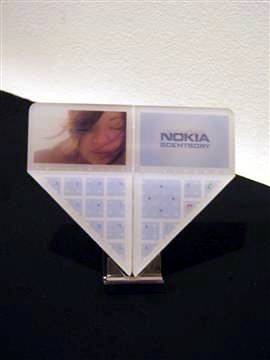Monday Topsight, June 19, 2006
 • Turning Greenhouse Gases into Greenhouse Glass: One of my mantras when I was writing at WorldChanging was that "we can't assume that all the tools we'll have for fighting global problems have already been invented." Today brings another example of why this is true: Italian researchers have found that carbon dioxide, under very high pressure, can be turned into something very much like glass.
• Turning Greenhouse Gases into Greenhouse Glass: One of my mantras when I was writing at WorldChanging was that "we can't assume that all the tools we'll have for fighting global problems have already been invented." Today brings another example of why this is true: Italian researchers have found that carbon dioxide, under very high pressure, can be turned into something very much like glass.
...by subjecting CO2 to even greater pressures – 400,000 to 500,000 atmospheres (40 to 50 gigaPascals) – the researchers created a novel, solid material. The CO2 molecules react to these conditions by forming a chaotic structure with oxygen molecules. The resulting material is transparent, tough, and has an atomic structure resembling that of ordinary window glass.
Of course, this material -- named "amorphous carbonia" -- is currently unstable outside of the ultra-high-pressure environment, so there's no guarantee that this will end up a real-world tool. But imagine how the game changes if carbon dioxide sequestration wasn't just an exercise is finding places to hide the gas, but was a resource for construction and art. (Via Brian Wang's Advanced Nanotechnology Blog)
• Mobile Phones of Tomorrow: Nokia asked design students at London's Central St Martins College of Art and Design to come up with mobile phones for the year 2015; the winning design was made into a non-functional prototype for display. Nokia's press release provides the most information, but other reports on the competition can be found at: Silicon.com, which also has photos of five of the phone designs; Cellular News; and Tech Digest. The winning design offers a "scent display" to accompany voice and image, giving the user a better sense of the environment surrounding the person at the other end of the line.
I love these "artifacts of the future" stories, in part because they give us some foreshadowing of what people could really end up doing with new technologies, and in part because they give us an unconventional perspective on present-day needs and concerns. This aspect is quite visible in the St Martins College designs, from the mobile phone built for blogging to the system providing new features as add-ons for old phones. But what problem, exactly, is the stinkphone "scent display" phone trying to resolve?
• Fly by Day, Please: Green Car Congress reports the findings of a study from the University of Reading that the contrails formed by aircraft at night are disproportionately responsible for the "radiative forcing" (i.e., global warming) caused by air travel. Although night air travel makes up only 25% of flights, it accounts for 60-80% of the climate impact. This is because contrails act like thin, high-altitude clouds, both reflecting incoming solar radiation and trapping warmth eminating from the Earth. Sunlight reflection only happens during the day, obviously, but the contrails trap warmth all day and all night.
Air travel is still a relatively small part of the global warming picture, but it's one that (a) is likely to keep increasing, (b) is damnably hard to fix (there just aren't that many good alternatives to hydrocarbons for aircraft fuel), and (c) is something that those of us with a strong global focus are loathe to give up. That said, reducing nighttime air travel as much as possible may be a reasonable step towards reducing the climate footprint of airplanes. Some night travel is unavoidable for certain destinations -- SF to London, for example -- but cross-country "red eye" flights may soon be a thing of the past.






Comments
A hearty hear hear to your comment on future tools to fighting global warming. This is my biggest problem with some environmentalists who tend to have a very luddite take on things.
Some environmental groups here in the UK are openly advocating a cessation of research into things like Genetic Engineering and nanotechnology. Which just happen to be the two fields that may be mission critical in combating global warming.
It's a bit nonsensical seeing as a few years ago they were saying more research was needed in these areas.
I've just stumbled across your blog and its good stuff. Keep up the good work.
Posted by: Jose | June 21, 2006 7:44 AM
Perhaps one day amorphous carbonia will be the material out of which we build technology - cell phones, computer chips, et cetera. And of course Bruce Sterling will foresee it...
Posted by: Abendigo Reebs | June 22, 2006 2:59 PM